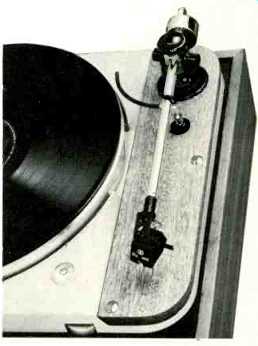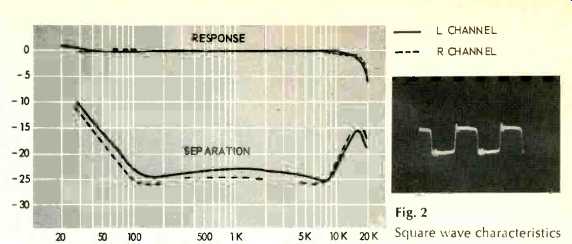
MANUFACTURER'S SPECIFICATIONS
TONEARM: Nominal Length: 9 inches.
Distance from Turntable Center: 8 1/2".
Rear Overhang: 2 1/2".
Size of Mounting Hole: 1 1/2" diameter.
Height Adjustment: 1 to 3 inches.
Cartridge Mounting Dimensions: Standard 1/2".
Length of Leads: 2'-9".
Accessories: Extra lightweight pickup shells; small counterweight for ultra lightweight cartridges.
Price $117.50.
CARTRIDGE: Model 4RC: Output 7.5 mV. at 5 cm/sec.
Frequency Range: 30-20,000 Hz.
Frequency Response: 30 Hz-16,000 Hz±3 dB.
Stylus Radius: 0.5-0.6 mil.
Stylus Tip Mass: Less than 1 mg.
Vertical Tracking Angle: 15 degrees.
Compliance: Lateral---15X10^-6 cm/dyne.
Vertical---4x10^-6 cm/dyne.
Channel Balance: Output from each channel within 1.0 dB. Inductance: 285 mH per channel.
Input Impedance: 47 k ohms.
D.c. Resistance: 4900 ohms per channel.
Recommended tracking force: 3.0-3.5 grams.
Price $65.00
DECCALIFT: Power Requirements: 6.3 volts a.c. at 0.1 amps.
Price: $26.00. With 6-volt transformer, $31.00. Price of complete phono pickup system: $195.00
Imported by Paoli High Fidelity, P.O. Box 876 Paoli, Penna. 19301
The Decca Mk 1 phono pickup system is the best performing pickup system I have ever come across. It measures better and sounds better than any other pickup I have tested to date. But a considerable effort in both skill and time is required in order to install the system properly.
This damps my enthusiasm in recommending it to everyone. Not that everyone wants to spend $195.00 for a pickup system, but there are others in this price range which are considerably less complex and easier to put together! To start with, the Mk 1 system consists of three components which we shall describe separately. They are the International tone arm, the Model 4RC phono cartridge, and a motor driven tone arm lowering/raising mechanism called the Deccalift. Aside from the Deccalift which does not affect the performance of the system when playing discs, we're not sure as to the contribution ratio of the arm to the cartridge and vice versa. It was simply too much work to test them separately with other components, for a second time. In any case, they work so well together that there is no reason to use them in any other way.
Because of their excellent design, and standard mounting dimensions of both arm and cartridge, however, we are confident that they are each capable of high quality performance with other well designed arms and cartridges.
The Decca International arm is an elaborately conceived unit designed to eliminate needless mass and still allow correct bass response. The arm is only 9 inches long and the key to its fine performance is in its pivot design and magnetic suspension. The tone arm bearing is an inverted jeweled unipivot which, as its name implies contacts the arm at only one small point.
This gives the arm remarkable freedom of motion, eliminating most of the friction. In fact, we were unable to measure any friction at the cartridge head using our dynamometer calibrated down to 0.03 grams.
The action of the pivot is damped by a silicone damping fluid that is poured, optionally, into the top of the tone arm during installation. The fluid does not increase friction in any measurable way, but helps damp out unwanted internal and external oscillations, including rumble. The fluid provides lateral, vertical, and torsional damping. The fluid is not put in at the factory so that it can't leak out in transit. But we strongly urge its use, even though the manufacturer says it's optional. Without the fluid, the arm becomes unstable at minor provocations such as a nick in the record being played. A further aid to the damping system is the magnetic suspension of the entire arm in the barrel. The pickup arm literally floats on a magnetic cushion which isolates it for the most part from the motor board.
Effective and accurately adjustable anti-skating compensation is magnetically applied and arranged so as to neutralize the component of skating force which tends to draw the pickup toward the center of the disc. The compensation is maximum at the outside of the disc and automatically decreases as the arm travels inward toward the center of the record.
An offset counterweight is used to balance the arm in both the lateral and vertical planes. The weight is de coupled from the alloy tube by means of a resilient rubber sleeve. A bubble level is built into the top of the tone arm. We estimate that this arm could enable good tracking at as little as 0.4 gram, if a cartridge designed to track at such force were available today.
The cartridge shell, or frame, as it could be called, is made of aluminum and weighs only 5 grams. In their effort to keep the weight down, Decca has come up with the barest cartridge support imaginable. While the support is effective and well fitting, all wires from the back of the cartridge, for instance, are visible and unprotected.
The arm which we received for review came together with the Decca lift, which we're not crazy about, though it works. The device is a motor-driven lifting/lowering mechanism manually activated in either direction by means of a rocker switch.
The switch can be mounted in the turntable, or at a remote location such as near the listening chair, or even in both places. While the device does lower and lift the tone arm as required, it does it so slowly and with so much delay between switch actuation and start of the arm motion cycle that one prefers to use the arm manually most of the time. Also, clicks and pops accompany the actuation. The design would be redeemed if an end-of-record sensor activated a lift cycle, at least. The lift mechanism consists of a 6-volt a.c. motor which is coupled via suitable reduction gears to the piston which lowers or raises the arm-supporting bar. Provision is made to add indicator lights which show direction of actuation-only a slight consolation to the lift's delayed action.
The motor shuts itself off automatically after either the lowering or raising cycle is completed.
The Decca Model 4RC cartridge is one of two recent Decca designs, the other being the elliptical Model SC4E. While it is magnetic, of the variable reluctance operating principle--which is not far removed from most popular moving-magnet designs--it is different in one important respect. It has no cantilever between the stylus and the magnet. Thus no motion is lost, nor additional resonance introduced. This permits more accurate tracing of the record grooves since mechanical to electrical conversion takes place just above the stylus. This, together with a hand-polished diamond stylus tip of very low mass, results in a most outstanding performer.
The recommended tracking force is 3 to 3.5 grams in a low-mass, low friction arm, such as the Decca International. According to the manufacturer, this recommended force while higher than other high-trackability cartridges with elliptical styli, produces less record wear due to the lower effective tip mass and polish.
We could detect no record wear during our tests-only a polishing effect, on new records, which concurs with what Decca says.
We installed the Mark 1 pickup system onto a Thorens Model TD124 turntable for our tests, tracking at just over 3 grams. The first thing we noticed was that turntable rumble was reduced from what we previously encountered in this turntable. We thought it might be a bass deficiency of the cartridge, until we ran the frequency response curves of Fig. 1.
These curves, are an automatically plotted response to CBS Labs' STR100 test record. Clearly, the cartridge is not bass deficient, and has the flattest response curve of any cartridge we ever tested. The difference between channels was less than 0.5 dB and the usual high-frequency peak is totally absent. The response rolls off steeply after 18 kHz, but is far better than the manufacturer's modest specifications. Separation was in excess of 20 dB throughout the midrange and reduced to 10 dB at 16 kHz, which is excellent. Figure 2 shows the square wave response.

Fig. 1-Frequency response and crosstalk; Fig. 2--Square wave characteristics
As might be expected, the s.ound reproduced via the Mk 1 system was outstanding. The clarity of brasses and percussion instruments was uncanny, and the cartridge tracked most high velocities extremely well. Bass, too, was clear and tight. The overall sound was reminiscent of earlier moving-coil designs, sans peaks. Distortion was judged to be very low.
We measured the cartridge's output voltage at 7.4 mV for both channels at 1000 Hz, referred to 3.54 cm/ sec rms 45-deg. velocity, which is as specified and high enough to drive all available preamps. It is a little higher than most cartridges, resulting in an improved signal to noise ratio.
We must conclude that the pickup system, as awkward to install as it is and not readily available at most dealers, is the best thing for playing records to have come along in a while.
Decca's installation instructions are not very good but the importer furnishes corrections plus additional clarifying information which makes installation possible.
Incidentally, these products are manufactured by Decca Gramophone Ltd. of England, which is in no way connected with Decca Records, a division of MCA, Inc. of New York.
(Audio magazine, Jun. 1970)
Also see:
Denon DL-103D Phono Cartridge, DA-307 Tonearm, and AU-320 Transformer (Sept. 1980)
= = = =